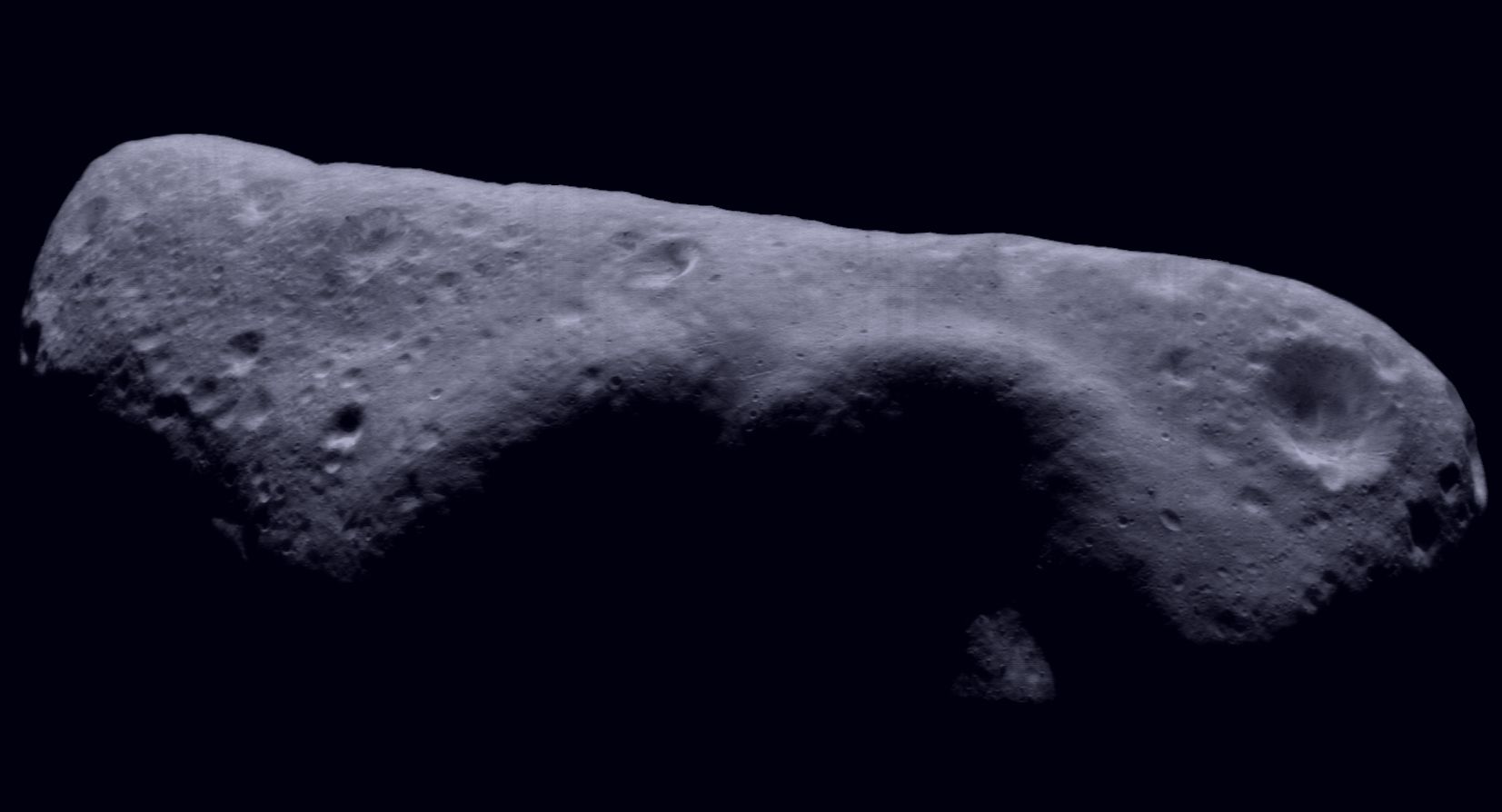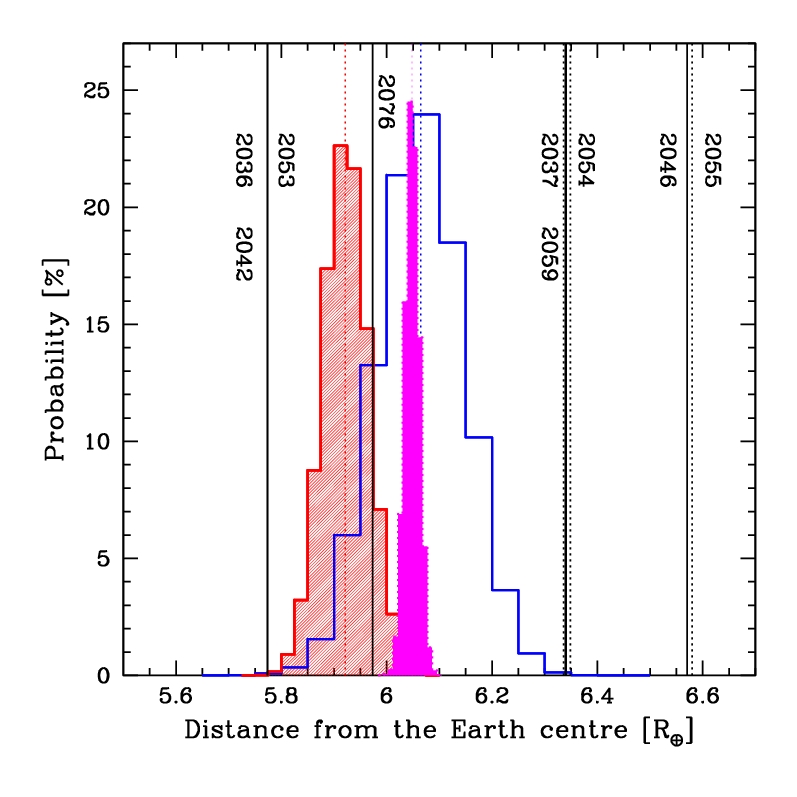| Solar System Dynamics Group |
 |
(99942) Apophis 2004 MN4 |
 |
| Solar System Dynamics Group |
 |
(99942) Apophis 2004 MN4 |
 |
Osculating orbit at the Epoch of 20130538 TT (Equinox: J2000)
| Epoch [TT] | a [AU] | e | i [deg] | Ω [deg] | ω [deg] | M [deg] | rms | |
|---|---|---|---|---|---|---|---|---|
| ± |
20130528 |
0.9221304537 0.0000000012 |
0.1911426875 0.0000000420 |
3.3304557 0.0000017 |
204.2231326 0.0000516 |
126.4440710 0.0000503 |
280.0057645 0.0000146 |
0″.35 |
Osculating orbit at the Epoch of 20290305 TT (Equinox: J2000)
| Epoch [TT] | a [AU] | e | i [deg] | Ω [deg] | ω [deg] | M [deg] | rms | |
|---|---|---|---|---|---|---|---|---|
| ± |
20290305 |
0.9223315606 0.0000000010 |
0.1912154080 0.0000000421 |
3.3420247 0.0000017 |
203.8626659 0.0000515 |
126.6985628 0.0000501 |
207.9735452 0.0000208 |
0″.35 |
 |
Distributions of the minimum distance of the asteroid
Apophis from the centre of Earth in 2029 04 13 derived for the
samples of 15000 virtual orbits. The minimum-distance histograms for shorter arc ( Model E in Królikowska, Sitarski & Sołtan, 2009, MNRAS) is shown with a blue solid line, for the model based on longer arc is shown with a red solid line and filled histogram (see below), while the model_2011 based on 1483 observations (2004 03 15 - 2011 03 14, see older results ) is shown by a magenta filled histogram. According to presented results it seems that the additional observations taken in 2011 reduce the asteroid's impact probabilities (in: 2036, 2037, 2044, 2054, 2056, 2059, 2076) effectively to nil (see figure and impact orbits given below) Thin dotted vertical lines representing the position of nominal orbits derived for Model E , for red model , and for the model_2011 are shown with a blue, red and magenta ink, respectively. Distances for selected impacts at dates indicated by labels are presented by black vertical lines. Impact orbit in 2076 is connected with very close encounter with Earth in 2051. Thus, the keyhole in 2029 is extremely narrow for the impact in 2076. |
March 25, 2011; credits: Sitarski & Królikowska , Space Research Centre PAS
|
Impact orbit for two dates (equ. J2000)
| Epoch [TT] | a [AU] | e | i [deg] | Ω [deg] | ω [deg] | M [deg] | rms | |
|---|---|---|---|---|---|---|---|---|
| dev/σ |
20060922 20360407 |
0.922263089 23.39 1.108425263 |
0.191058800 -28.18 0.191388652 |
3.3313299 -7.20 2.1710663 |
204.4601578 3.06 203.4807440 |
126.3953486 -2.52 70.3084804 |
84.7865779 -9.22 303.9199150 |
0″.23 |
Impact date: 2036 04 13.366 (UT) Vimpact= 12.914 km/sec Ψimpact = 31°.49
Impact orbit for two dates (equ. J2000)
| Epoch [TT] | a [AU] | e | i [deg] | Ω [deg] | ω [deg] | M [deg] | rms | |
|---|---|---|---|---|---|---|---|---|
| dev/σ |
20060922 20370407 |
0.922263248 -26.86 1.093191964 |
0.191058345 5.42 0.186818609 |
3.3313233 1.57 2.3248608 |
204.4598383 25.10 203.4807051 |
126.3956779 -26.80 73.9648356 |
84.7864392 20.00 300.0418976 |
0″.28 |
Impact date: 2037 04 13.640(UT) Vimpact= 12.883 km/sec Ψimpact = 39°.60
Impact orbit for two dates (equ. J2000)
| Epoch [TT] | a [AU] | e | i [deg] | Ω [deg] | ω [deg] | M [deg] | rms | |
|---|---|---|---|---|---|---|---|---|
| dev/σ |
20060922 20440407 |
0.922263249 -27.18 1.108351655 |
0.191058273 10.74 0.190962846 |
3.3313260 -2.02 2.2963983 |
204.4599727 15.83 203.2835273 |
126.3955185 -15.05 70.2655109 |
84.7864730 12.88 304.0443749 |
0″.26 |
Impact date: 2044 04 13.260(UT) Vimpact= 12.900 km/sec Ψimpact = 56°.03
Impact orbit for two dates (equ. J2000)
| Epoch [TT] | a [AU] | e | i [deg] | Ω [deg] | ω [deg] | M [deg] | rms | |
|---|---|---|---|---|---|---|---|---|
| dev/σ |
20060922 20460407 |
0.922263320 -47.63 1.086470920 |
0.191058015 28.57 0.184791149 |
3.3313150 12.56 2.4170949 |
204.4604322 -15.75 202.9716579 |
126.3951506 11.99 75.4319576 |
84.7863472 38.66 298.7128495 |
0″.28 |
Impact date: 2046 04 13.336(UT) Vimpact= 12.761 km/sec Ψimpact = 3°.95
Impact orbit for two dates (equ. J2000)
| Epoch [TT] | a [AU] | e | i [deg] | Ω [deg] | ω [deg] | M [deg] | rms | |
|---|---|---|---|---|---|---|---|---|
| dev/σ |
20060922 20540407 |
0.922263255 -29.08 1.086722366 |
0.191058197 16.35 0.185182832 |
3.3313212 4.36 2.3527613 |
204.4601565 3.15 203.0276175 |
126.3953852 -5.22 75.3931868 |
84.7864267 22.63 298.6950620 |
0″.24 |
Impact date: 2054 04 13.397(UT) Vimpact= 12.540 km/sec Ψimpact = 36°.64
Impact orbit for two dates (equ. J2000)
| Epoch [TT] | a [AU] | e | i [deg] | Ω [deg] | ω [deg] | M [deg] | rms | |
|---|---|---|---|---|---|---|---|---|
| dev/σ |
20060922 20550407 |
0.922263322 -50.25 1.082023691 |
0.191057966 33.40 0.183918494 |
3.3313189 7.41 2.4075413 |
204.4602070 -0.33 203.0562387 |
126.3953508 -2.68 76.6258724 |
84.7863627 36.11 297.2039796 |
0″.28 |
Impact date: 2055 04 13.726(UT) Vimpact= 12.743 km/sec Ψimpact = 8°.95
Impact orbit for two dates (equ. J2000)
| Epoch [TT] | a [AU] | e | i [deg] | Ω [deg] | ω [deg] | M [deg] | rms | |
|---|---|---|---|---|---|---|---|---|
| dev/σ |
20060922 20560407 |
0.922263252 -28.13 1.076905864 |
0.191058221 14.58 0.183014100 |
3.3313212 4.36 2.3501801 |
204.4600912 7.65 203.1436077 |
126.3954481 -9.85 78.1865523 |
84.7864263 22.71 296.2756880 |
0″.24 |
Impact date: 2056 04 13.187(UT) Vimpact= 13.047 km/sec Ψimpact = 43°.13
Impact orbit for two dates (equ. J2000)
| Epoch [TT] | a [AU] | e | i [deg] | Ω [deg] | ω [deg] | M [deg] | rms | |
|---|---|---|---|---|---|---|---|---|
| dev/σ |
20060922 20590407 |
0.922263252 -28.13 1.102586438 |
0.191058179 17.68 0.189249766 |
3.3313198 6.22 2.3137198 |
204.4601807 1.48 203.0819267 |
126.3953682 -3.96 71.6561664 |
84.7864285 22.25 302.1232175 |
0″.23 |
Impact date: 2059 04 13.950 (UT) Vimpact= 12.813 km/sec Ψimpact = 74°.57
Impact orbit for two dates (equ. J2000)
| Epoch [TT] | a [AU] | e | i [deg] | Ω [deg] | ω [deg] | M [deg] | rms | |
|---|---|---|---|---|---|---|---|---|
| dev/σ |
20060922 20760407 |
0.922263146 5.54 1.086675424 |
0.191058604 -13.75 0.185403406 |
3.3313282 -4.84 2.2686612 |
204.4601380 4.36 202.6213668 |
126.3953735 -4.30 75.4858831 |
84.7865288 1.00 299.3072400 |
0″.22 |
Impact date: 2076 04 12.693(UT) (UT) Vimpact= 12.638 km/sec Ψimpact = 18°.25